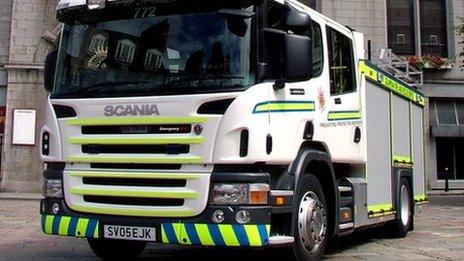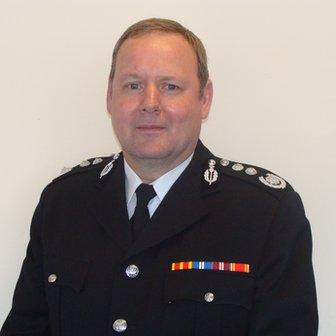Why Grampian is losing its unusual white fire engines, and other questions...
- Published

Grampian Fire Service's white fire engines will be phased out after 1 April
Scotland's eight regional fire and rescue services are to merge into a single Scottish Fire and Rescue Service on 1 April.
But what exactly will be different if you ring 999? And what is the future for Grampian's unusual white fire engines?
When Grampian fire service announced on 1 April, 1998, that it was planning to paint all of its fire engines white, it had to reassure people it was not an April Fool's Day hoax.
The decision in fact was based on a scientific study that showed that people find white and yellow the easiest colours to see at high speeds - and red and grey the hardest to make out.
But fifteen years later, Grampian is set to lose its 55 distinctive white fire engines.
They will be gradually phased out and replaced with regulation red after Scotland's eight regional fire services merge into one on 1 April.
So what else will be changing? Here we answer eight questions about fire reform.
What is happening?
The government says it needs to find major savings in the fire service.

The headquarters of the new single fire service will be in Perth, and there will be three operational 'hubs' in the north, west and east
As part of efforts to achieve this, Scotland's eight regional fire services - Dumfries & Galloway, Fife, Central Scotland, Grampian, Highlands & Islands, Lothian & Borders, Strathclyde, and Tayside - are being merged into one.
The new body will be called the Scottish Fire and Rescue Service (SFRS).
Instead of having eight of everything - eight fire chiefs, eight press offices, eight training centres - savings can be made by pooling resources into one, the government says.
It says that making savings in this way will protect frontline staff and resources.
The new headquarters will be in Perth, and there will be three operational 'hubs' in the north, west and east.
Scotland's eight regional police forces are also being merged into one single force as part of the same reforms.
So what happens if you call 999 after 1 April?
According to Alasdair Hay, chief officer of the new single fire service, the public should not notice any difference post 1 April.
999 calls will still be put through to the same regional call centres, and fire fighters will be deployed in the same way.
"We don't expect any big bang on April 1," says Alan Paterson of the Scottish Fire Union (SFU).
"Fire engines will go out as normal. The same local fire-fighters are in place. The public should be oblivious to the changes."
Changes to call centres could be looked at in the long term, a spokesperson for SFRS said.
What will the new Scottish Fire and Rescue Service look like?
If you look carefully, you might be able to spot small changes already.
Work has already been started to change insignia, crests and branding at the regional services to the new SFRS logo.
Many of the regional logos feature the same two thistles and a flame, but some have their own distinct crests.
The Dumfries and Galloway crest features a unicorn and a stag, for example.
How much is the government saving?
The Scottish government expects to save £130m a year from police and fire reform combined after the first five years.
From the Fire Service alone, ministers expect to save £25m a year once the reform process is complete.
The process of merging the eight existing fire services together will cost money - early plans quoted a figure of £25m - but the government says that most of the costs will be covered by "early savings".
The government will be providing £19m of funding over three years for the transition.
Are firefighters' jobs under threat?
The fire services in Scotland employ around 9,000 people, according to figures from March 2012.
Fire unions have been promised that there will be no compulsory redundancies of either uniform or non-uniform staff.
A process of offering voluntary redundancies has been going on for some time.
On 1 April, all staff will be automatically transferred across to the new single fire service.
"The fire fighters on the shop floor shouldn't see any difference," says Mr Paterson of the SFU.
Are any buildings being sold off?
A spokesperson for the SFRS said there are no plans at the moment to sell off any fire service buildings.

Chief Officer Alasdair Hay says the fire service is ready for the changeover on 1 April
However, it is possible that leases on buildings that are not owned by the fire service, for example some surplus training facilities, will be allowed to expire.
Resources for dealing with chemical, biological, radiological or nuclear incidents, which are currently distributed across all eight services will be transferred to the single service.
Specialist teams for water rescue or rope rescue will also be combined.
How will the new fire service be inspected?
A new governing board called the Scottish Fire and Rescue Service Board has been set up to inspect and scrutinise the new single service.
Its chairman, Pat Watters CBE, former president of the Scottish councils governing body Cosla, says there will be no loss of accountability.
"I do understand, if there is any change at all, people are a bit wary of that change," he said.
However, he said he was confident the same service would be given across Scotland after 1 April.
Is the Scottish Fire and Rescue Service prepared for the 1 April merge?
Chief Officer Hay says the fire service is prepared for the changes ahead.
"We have appointed an exceptional team of individuals to lead the new national Scottish Fire and Rescue Service," he said.
Fire union chair Mr Paterson said: "It is a gradual process. It would be naïve to say there would no teething problems, but we don't anticipate any serious problems."
- Published6 March 2013
- Published9 January 2013
- Published16 August 2012
- Published31 August 2012